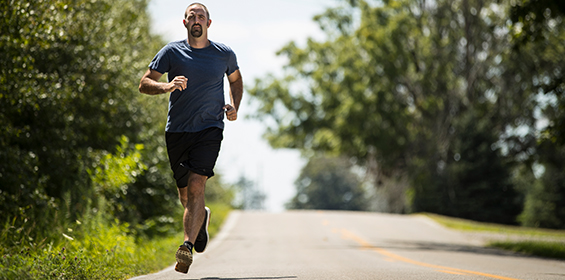Patellofemoral syndrome, or “runner’s knee,” is a common problem in active individuals that can have a serious impact on a person’s ability to participate in activities. Symptoms usually consist of vague, dull or achy pain in the front of the knee that worsens with walking up and down stairs, squatting, kneeling and prolonged sitting. Pain usually begins gradually without a specific injury; however, direct trauma to the kneecap (patella) or a kneecap dislocation can sometimes initiate the problem. Another common cause is sudden increased activity, such as participation in a sport or beginning an exercise routine such as running or weightlifting. It is a condition that is more common in women, especially athletically active young women. There are numerous theories as to why this is the case, such as gender differences in the pelvis, positioning of the knee joint and leg strength.
Causes of Patellofemoral Syndrome/Runner’s Knee
Patellofemoral syndrome is caused by stress being on the cartilage that is generated from flexing the knee. With the knee straight (extended) there is little to no force through the joint. As the knee bends, the force starts to become significant at around 45 degrees of flexion and increases steadily until 60 degrees. At that point, there is a leveling out of the force until another steep increase with flexion past 90 degrees. Studies have shown that these forces are estimated to be three times a person’s body weight when climbing stairs, five times body weight when running and can be in excess of seven times body weight when squatting. With this in mind, it should not be surprising that runner’s knee is a common problem with athletes. This is also the reason that the thickest layer of cartilage in the entire body is located under the kneecap.
The patellofemoral compartment of the knee joint is relatively complex, with many factors that could be contributing to pain. In most cases, patellofemoral pain can be attributed to malalignment, soft tissue tightness or a combination of the two. Other contributing factors include overuse, muscle imbalance and inadequate stretching. Pain that begins in another part of the body, such as the back or hip, may also cause pain in the knee.
Anatomy
The kneecap is actually shaped like a triangle or keel that fits in a groove (trochlea) on the front of the large thigh bone called the femur. Malalignment means that the keel of the kneecap is not tracking properly in the middle of the trochlea when the knee bends. This can cause uneven wear or breakdown of the cartilage in both the kneecap and the trochlea. Although malalignment can be due to complex reasons, the most common way to address it is by stretching the surrounding soft tissues and using the surrounding muscles to counteract the abnormal tracking. Regardless of the cause, excessive stress on the kneecap results in pain and can also cause breakdown of the cartilage on the undersurface of the kneecap, commonly referred to as arthritis.
Prevention
There are several ways to decrease your risk of developing patellofemoral syndrome, including:
- Stay physically fit. Carrying extra body weight will cause your kneecap to constantly be under excessive stress. Increased body weight means increased forces through the joint.
- Stretch before and after activity to keep the supporting structures around the knee flexible. Those muscles are also less likely to be irritated with activity.
- Avoid sudden changes in the intensity or duration of exercise to help reduce overuse injuries.
- Avoid running hills or inclining a treadmill. These activities lead to more bending of the knee and thus increased forces through the patellofemoral joint.
- When lifting weights, avoid flexing the knee past 45 degrees and avoid deep squats. Remember that although a full range of motion is best in building strength, muscles work through moving a joint, and the increases in strength are worthless if that joint is painful with movement.
Treatment
When a patient presents with kneecap pain, an orthopedic doctor will likely assess several factors including a history and duration of sports or activity participation and aggravating events. Additionally, a physical exam of the knee is necessary and may include an exam of the back, pelvis, hips, ankles and feet. Flexibility and strength of the lower extremity joints and muscles may be checked for abnormalities. Commonly, x-rays of the knee are taken, while more complex imaging, such as an MRI or a CT, are rarely necessary.
Although there are ways to treat patellofemoral pain syndrome, there are no quick fixes. It is often most resolved through non-surgical treatments such as icing the irritated area, taping and/or knee bracing, shoe inserts, taking anti-inflammatory medications, physical therapy and activity modification. For most patients, activity modification is the best way to treat patellofemoral syndrome, which can be frustrating for an athlete as it often requires resting with no participation or training for their sport.
Once the initial pain and swelling decrease, reconditioning to regain pain-free full range of motion and strength is recommended. A formal program under the direction and supervision of a physical therapist should be prescribed by your physician. Most likely, the majority of your time will be spent strengthening your quadriceps muscles. These muscles in the front of the thigh help to pull your kneecap through its groove and, if strengthened, can counteract the abnormal forces caused by malalignment and soft tissue tightness.
With proper non-surgical treatment, the majority of patients are able to get back to doing the activities they enjoy. If you are experiencing symptoms of patellofemoral syndrome, we encourage you to seek treatment with a sports medicine doctor or physical therapist – and we would love to help! To schedule an appointment, call 800-622-6575 or Chat with us at ciocenter.com.

